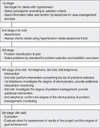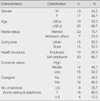Abstract
Purpose
The purpose of this study was to analyze effects of a community-based case management program for clients with hypertension living in the community.
Methods
The research design was a one group pre and post-test design with 30 participants with hypertension who agreed to participate in the 8-12 week case management program provided by case managers from the National Health Insurance Corporation in 2002. Data were collected three times, before and after the case management services, and 6 months later. Outcomes included changes in blood pressure, knowledge of hypertension and daily life practices, including alcohol consumption, smoking, exercise, and medication adherence.
Results
Repeated-measures ANOVA and post-hoc tests of means revealed significant differences before and after service for systolic blood pressure, daily life practices (monitoring body weight and BP, low salt and cholesterol and high vegetable diet, and stress-relief practices), and exercise. The goal for medication adherence was attained after service. Significant improvements from baseline to 6 months after service were observed in measures of salt and vegetables in diet. There were no significant differences on hypertension knowledge, alcohol consumption or smoking behavior between before service and after, and at 6 months.
Figures and Tables
References
1. Bramley TJ, Gerbino PP, Nightengale BS, Frech-Tamas F. Relationship of blood pressure control to adherence with antihypertensive monotherapy in 13 managed care organizations. Journal of Managed Care Pharmacy. 2006. 12:239–245.
2. Chan S, MacKenzie A, Ng DT, Leung JK. An evaluation of the implementation of case management in the community psychiatric nursing service. Journal of Advanced Nursing. 2000. 31:144–156.
3. Chang SO, Shin SR, Kim HK, Kim SS, Ju EA. Changes in smokers' perception about smoking before and after participation in a hospitalized smoking cessation program. Journal of Korean Academy of Nursing. 2005. 35:1163–1173.
4. Choi IH. Changes of blood pressure and the performance of self-management of hypertension patients following the case-management. 2007. Busan: Kosin University;Unpublished master's thesis.
5. Colhoun HM, Dong W, Poulter NR. Blood pressure screening, management and control in England: Results from thehealth survey for England 1994. Journal of Hypertension. 1998. 16:747–752.
6. Dally DL, Dahar W, Scott A, Roblin D, Khoury AT. The impact of health education program targeting patients with high visit rates in managed care organization. American Journal of Health Promotion. 2002. 17:101–111.
7. Drevenhorn E, Kjellgren KI, Bengtson A. Outcomes following a programme for lifestyle changes with people with hypertension. Journal of Clinical Nursing. 2007. 16:144–151.
8. Friedman RH, Kazis LE, Jette A, Smith MB, Stollerman J, Torgerson J, et al. A telecommunications system for monitoring and counselling patients with hypertension. Impact on medication adherence and blood pressure control. American Journal of Hypertension. 1996. 9:285–292.
9. Ginsberg GM, Viskoper JR, Fuchs Z, Drexler I, Lubin F, Berlin S, et al. Partial cost-benefit analysis of two different modes of nonpharmacological control of hypertension in the community. Journal of Human Hypertension. 1993. 7:593–597.
10. Joffres MR, Ghadirian P, Fodor JG, Petrasovits A, Chockalingam A, Hamet P. Awareness, treatment, and control of hypertension in Canada. American Journal of Hypertension. 1997. 10:1097–1102.
11. Joint National Committee (JNC). The sixth report of the Joint National Committee on detection, evaluation, and treatment of high blood pressure. Archives of Internal Medicine. 1997. 157:2413–2446.
12. Kim CY, Kim EY, Kim CH, Kim HS, Kim HG, Nam HS, et al. Development and evaluation of case management program for the insureds of National Health Insurance. 2003. Seoul: National Health Insurance Corporation.
13. Kim YM, Shin EY, Lee KS. Effects of the case management program for the elderly with hypertension. Korean Journal of Gerontology. 2006. 26:477–492.
14. Ko IS, Kim GS, Lim MH, Lee KJ, Lee TW, Park HS, et al. Effects of health education on the knowledge and self-care of hypertension for visiting nursing clients. Journal of Korean Academy of Public Health Nursing. 2007. 21:134–145.
15. Lee GS, Kim CH, Shin JH, Ryu WS, Lee GM, Shin EY, et al. A study of man power development and monitoring system in case management program of National Health Insurance. 2005. Seoul: National Health Insurance Corporation.
16. Lee JS, Oh SY, Han HS, Yi YJ. The coping experience in hypertensive clients. Journal of Korean Academy of Nursing. 2001. 31:759–769.
17. Lee WW. A study on the medical service use of high blood pressure patients through the case management program and on the effect of their self-management performing level - Focused on the data of National Health Insurance Corporation. 2007. Daegu: Yeungnam University;Unpublished master's thesis.
18. Marques-Vidal P, Tuomilehto J. Hypertension awareness, treatment, and control in the community: Is the 'rule of halves' still valid? Journal of Human Hypertension. 1997. 11:213–220.
19. Nelson MR. The JNC-7 hypertension guidelines. Journal of American Medical Association. 2003. 290:1312.
20. Newell M. Using nursing case management to improved health outcomes. 1996. Gaithersburg, MD: An Aspen Publication.
21. Nho HS, Kim HS. Hypertension and exercise prescription. Journal of Korean Society of Living Environmental System. 2000. 7:1–8.
22. Nine SL, Lakies CL, Jarrett HK, Davis BA. Community-based chronic disease management program for African Americans. Outcomes Management. 2003. 7:106–112.
23. Park JH, Park JH, Lee SY, Kim SY, Shin Y, Kim SY. Disparities in antihypertensive medication adherence in persons with disabilities and without disabilities: Results of a Korean population-based study. Archives of Physical Medicine and Rehabilitation. 2008. 89:1460–1467.
24. Park NH. The effect of self-help programs for hypertensives in community areas. Journal of Korean Society of Health Education and Promotion. 2003. 20:207–219.
25. Park OJ, Hong MS, Jang KS, Kim JY. The effect of social support on compliance with sick role behavior in hypertensive clients and duration of the effect for up to 6 months. Journal of Korean Academy of Nursing. 1998. 28:159–170.
26. Pender NJ. Health promotion in nursing practice. 1996. 3rd ed. Stanford, CT: Appleton & Lange.
27. The Korea Institution for Health and Social Affairs (KIHSA). National health and nutrition survey 2005. 2006. Seoul: Ministry of Health and Welfare.
28. Tipton CM. Exercise, training and hypertension: An update. Exercise and Sport Sciences Reviews. 1991. 19:447–505.
29. Yoo WS, Kim MH, Kim YM, Kim EY, Kim CH, Kim HG, et al. Development of job manual for progressive reorganization in case management program for the insureds of National Health Insurance. 2007. Seoul: National Health Insurance Corporation.
30. Yoo YS, Cho OH, Park SK, Jung HS, Kim SI. Development of a web-based hypertensive patient management system using short message service (SMS): Pilot study. Clinical Nursing Research. 2005. 11:57–70.




 PDF
PDF ePub
ePub Citation
Citation Print
Print





 XML Download
XML Download